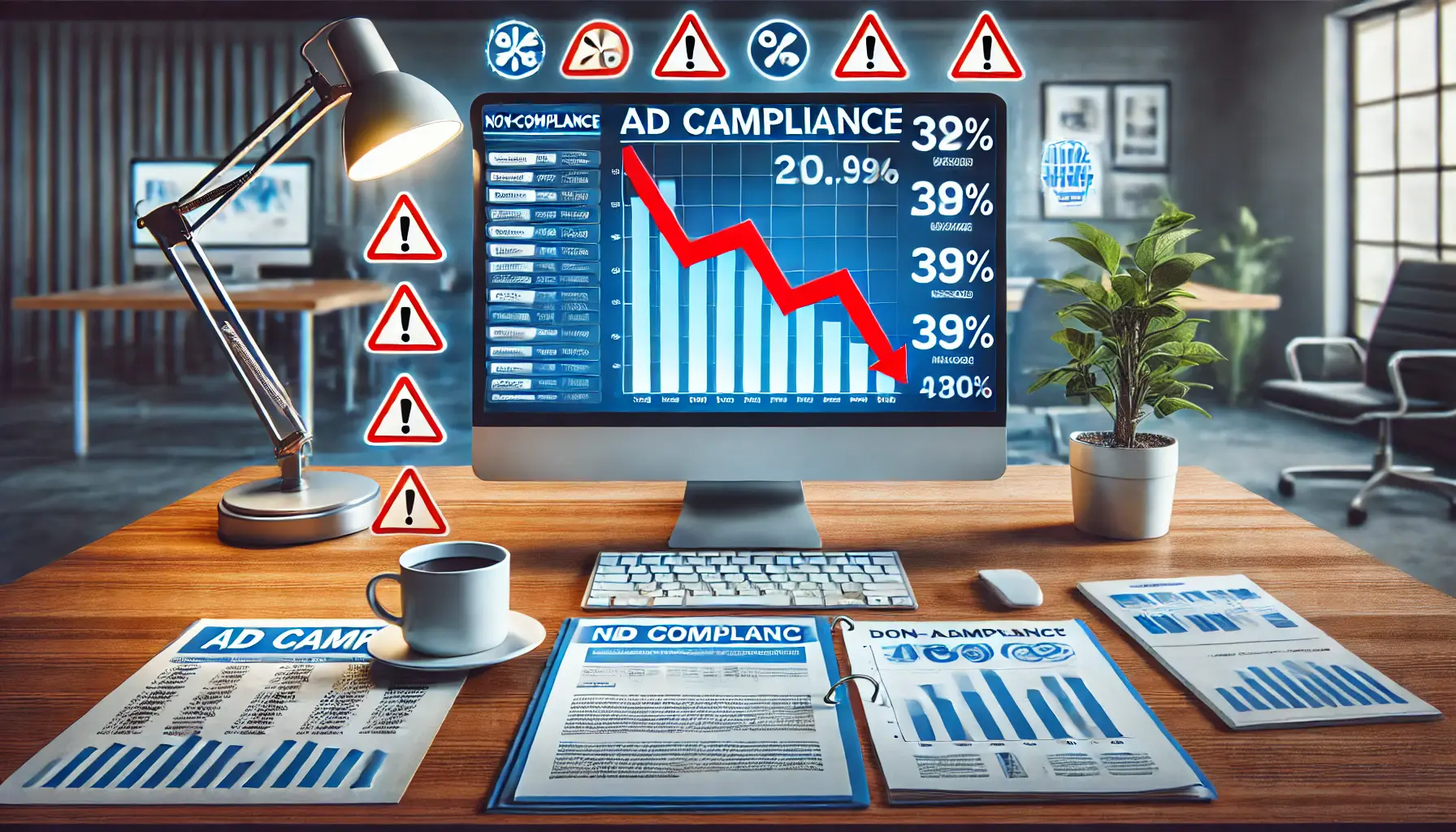When creating successful display ad campaigns, perhaps the most crucial thing is often left in the back of one’s mind: complianceAdhering to rules, regulations, or policies..
Following all of Google AdsGoogle's online advertising platform that allows advertisers to display ads to users. policies is a must to avoid penaltiesPunishments or consequences for failing to comply with rules or policies. and build trust among your target audience.
Failure to comply can result in the suspension of your account, blowing budgets unnecessarily, and, worst of all, loss of credibility—a reason this section needs to be tackled proactively.
In this article, we’ll walk you through actionable tips to help you maintain compliance while running effective display ad campaigns.
- Understanding Compliance in Google Display Ads
- Ensuring Ad Content Meets Policy Guidelines
- Optimizing Landing Pages for Compliance with Google Policies
- Observation and Maintenance of Compliance in Display Ad Campaigns
- Leveraging Compliance to Enhance Ad Performance
- Compliance Is Key to Success in Display Ad Campaigns
- Frequently Asked Questions on Compliance Tips for Display Ad Campaigns
Understanding Compliance in Google Display Ads
Compliance in Google Display Ads refers to adhering to the guidelines and policies set by Google to ensure advertisements are ethical, truthful, and non-deceptive.
It’s not just about avoiding violations—it’s about creating a safe and trustworthy experience for users engaging with your ads.

Visual representation of compliance in digital advertising through a professional workspace.
What is Compliance in Digital Advertising?
Compliance in digital advertising encompasses the rules and regulations that govern how ads are created, presented, and delivered to audiences.
These rules are set in place to make sure online advertisements are transparent, fair, and safe.
- Transparency: Ensuring that information regarding your product or service is clear and not misleading.
- Fairness: Preventing misleading or manipulative tactics in advertising.
- Safety: Ensuring ads do not carry harmful or prohibited content.

Illustration emphasizing the importance of compliance in Google Ads campaigns through a professional setup.
Why Compliance Matters for Google Ads Campaigns
Adhering to compliance standards is important because it safeguards your campaigns from being flagged or penalized by Google.
It also builds user trust and ensures that your brand remains credible in the highly competitive digital landscape.
- Helps maintain a positive brand image.
- Avoids wasted ad spend due to account suspensions.
- Enhances ad performance and user engagement.

Visual representation of common compliance issues in display advertising with a focus on error messages and challenges.
Common Compliance Issues in Display Advertising
Several issues can cause non-compliance in display ad campaigns.
Identifying and addressing these challenges early can save you time and resources in the long run.
- Use of restricted or prohibited content.
- Misleading or exaggerated claims in ad copy.
- Inaccurate targeting or misrepresentation of products.

Illustration of the negative impact of non-compliance on digital advertising campaigns, highlighting poor performance and stress.
How Non-Compliance Can Impact Your Campaigns
Failing to comply with Google Ads policies can lead to serious consequences.
Here’s how non-compliance can negatively affect your campaigns:
- Ad disapprovals or restrictions, reducing the reach of the campaign.
- Temporary or permanent suspension of accounts.
- Lack of trust and credibility on the part of the audience.
Compliance ensures that ads are truthful, non-deceptive, and safe, fostering trust and credibility among users.

Illustration of the process of ensuring ad content complies with policy guidelines, with attention to detail and review.
Ensuring Ad Content Meets Policy Guidelines
Writing display ads that meet all of Google’s policies will help ensure the success of your campaigns.
Besides preventing ad disapprovals, following these guidelines will enhance user experience and build trust with your audience.
Let’s explore how you can ensure your ad content meets Google’s policy standards.

Illustration of the process of reviewing Google Ads policy for display ads in a modern digital marketing workspace.
Reviewing Google Ads Policy for Display Ads
Before crafting your ad creatives, it’s crucial to familiarize yourself with Google’s advertising policies.
These guidelines cover various aspects, including prohibited contentContent that is explicitly forbidden by Google Ads policies., restricted productsProducts that have specific limitations or conditions for advertising., and editorial standardsGuidelines for writing and formatting content to ensure professionalism and consistency..
Regularly reviewing these policies will help you stay compliant and avoid potential pitfalls.
- Prohibited Content: Ensure your ads do not promote counterfeit goods, dangerous products, or inappropriate content.
- Restricted Products: Some products and services, like alcohol or gambling, have specific advertising restrictions.
- Editorial Standards: Maintain professionalism in your ad copy, avoiding excessive capitalization or unclear URLs.

Illustration of creating policy-compliant ad creatives in a professional digital marketing workspace.
Tips for Creating Policy-Compliant Ad Creatives
Designing ads that align with Google’s policies requires attention to detail.
Here are some guidelines to help you design compliant ad creatives:
- Use High-Quality Images: Use clear, relevant, and high-resolution images that accurately depict your product or service.
- Craft Clear and Honest Ad Copy: Avoid deceptive claims; ensure your ad copy clearly states what you are offering.
- Include a Clear Call-to-Action (CTA): Direct users on the next steps with a straightforward and honest CTA.
- Adhere to Technical Specifications: Ensure that your creatives meet the size and format specifications of Google Ads to avoid disapprovals.

Illustration of avoiding restricted and prohibited content in digital advertising, symbolizing careful compliance.
Avoiding Restricted and Prohibited Content
To maintain compliance, it is crucial to avoid content that is restricted or prohibited by Google.
This includes:
- Adult Content: Ads promoting adult-oriented content are not allowed.
- Dangerous Products: Avoid advertising weapons, explosives, or tobacco products.
- Inappropriate Content: Refrain from using hateful, violent, or discriminatory language or images.

Illustration of examples of ad content that violates guidelines, highlighting non-compliant ad features.
Examples of Ad Content That Violates Guidelines
Understanding what constitutes a policy violation can help you avoid common mistakes.
Here are some examples of non-compliant ad content:
- Deceptive Headlines: Your ad claims that a product can guarantee unrealistic results.
- Deceptive Display URLs: The display URL is different from the domain of the actual landing page.
- Sexually Suggestive or Shocking Images: An image that may be sexually suggestive or shocking.
By following these tips and studying Google’s policies regularly, you will be well-equipped to create ad content that is compelling yet compliant, ensuring a seamless and successful advertising experience.
- Write clear and professional ad copy.
- Use high-quality, relevant images.
- Adhere to Google’s technical specifications.

undefined
Optimizing Landing Pages for Compliance with Google Policies
The compliance of the landing page with Google’s policies is the success mantra for any display ad campaign.
A compliant landing page saves one from ad disapprovals and helps in gaining user trust for better conversion rates.
Let’s explore how you can optimize your landing pages to meet policy guidelines effectively.

undefined
Key Elements of a Policy-Compliant Landing Page
To create a landing page that adheres to Google’s policies, focus on the following elements:
- Relevant Content: Ensure that the content on your landing page directly relates to the ad copy and keywords, providing users with the information they expect upon clicking the ad.
- Transparency: Clearly disclose all necessary information about your products or services, including pricing, terms, and conditions, to foster trust and comply with Google’s transparency requirements.
- Easy Navigation: Design your landing page with a clear and intuitive layout, making it easy for users to find information and take desired actions without confusion.
- Mobile Optimization: With a significant number of users accessing content via mobile devices, ensure your landing page is mobile-friendly, providing a seamless experience across all devices.
- Fast Loading Speed: Optimize your landing page to load quickly, as slow-loading pages can lead to high bounce rates and negatively impact user experience.

Illustration of avoiding misleading claims and promotions in digital advertising, emphasizing compliance and professionalism.
Avoiding Misleading Claims and Promotions
It’s essential to maintain honesty and accuracy in your landing page content to comply with Google’s policies:
- Truthful Statements: Avoid making exaggerated or false claims about your products or services. Ensure all information is accurate and verifiable.
- Clear Offers: If you’re promoting discounts or special offers, clearly state the terms and conditions, including any limitations or expiration dates, to prevent misleading users.
- Authentic Testimonials: Use genuine customer testimonials and avoid fabricating reviews, as authenticity is key to building trust and complying with policies.

Illustration of maintaining transparency with users in digital advertising, emphasizing clarity and user trust.
How to Maintain Transparency with Users
Transparency is a cornerstone of compliance and user trust:
- Comprehensive Privacy Policy: Provide a clear and accessible privacy policy that informs users about data collection and usage practices.
- Contact Information: Include visible and accurate contact details, such as an email address or phone number, to establish credibility and allow users to reach you easily.
- Detailed Product Information: Offer thorough descriptions of your products or services, including features, benefits, and any potential limitations, enabling users to make informed decisions.

Illustration of tools used to audit landing pages for compliance, with a focus on review and analysis.
Tools to Audit Your Landing Pages for Compliance
Regular audits of your landing pages can help maintain compliance and optimize performance:
- Google’s Mobile-Friendly Test: Assess how easily users can navigate your page on mobile devices and identify areas for improvement.
- PageSpeed Insights: Analyze your landing page’s loading speed and receive suggestions to enhance performance.
- Google Ads Policy Manager: Monitor your account for any policy violations and receive alerts to address issues promptly.
- Third-Party Compliance Tools: Utilize tools like SEMrush or Ahrefs to audit your landing pages for SEO and compliance factors, ensuring adherence to best practices.
By focusing on these aspects, you can optimize your landing pages for compliance, providing a trustworthy and user-friendly experience that aligns with Google’s policies and enhances the effectiveness of your display ad campaigns.
- Provide relevant content aligned with ad copy.
- Ensure transparency in pricing and terms.
- Optimize for mobile and loading speed.

Illustration of observing and maintaining compliance in display ad campaigns, emphasizing attention to detail and monitoring.
Observation and Maintenance of Compliance in Display Ad Campaigns
Compliance for ongoing display ad campaigns is vital for sustained success.
Regular monitoring and adherence to Google’s advertising policies can help prevent ad disapprovals, protect your brand’s reputation, and optimize campaign performance.
Let’s find out how effectively one can manage compliance in their display advertisement campaigns.

Illustration of conducting periodic audits of ad content and landing pages, emphasizing review and analysis.
Periodic Audits of Ad Content and Landing Pages
Periodic auditing of the ad content and landing page will ensure that both are compliant with Google policies.
This proactive approach helps identify and rectify potential issues before they escalate.
- Schedule Routine Reviews: Set a regular schedule to review your ads and landing pages for compliance, ensuring all content aligns with current policies.
- Utilize Compliance Checklists: Develop checklists based on Google’s advertising policies to systematically assess your content during audits.
- Engage Multiple Reviewers: Involve team members in the review process to gain diverse perspectives and catch potential compliance issues.

Illustration of staying updated with policy changes in digital advertising, symbolizing continuous monitoring and research.
Staying Updated with Policy Changes
Google frequently updates its advertising policies to enhance user experience and adapt to new regulations.
Staying informed about these changes is essential for maintaining compliance.
- Subscribe to Official Updates: Sign up for notifications from Google’s Advertising Policies Help Center to receive timely updates on policy changes.
- Regularly Visit the Policy Center: Frequently review the Google Ads Policy Center to stay informed about the latest guidelines and requirements.
- Participate in Industry Forums: Engage in digital marketing communities to discuss and learn about recent policy updates and their implications.

Illustration of utilizing Google’s Policy Manager Tool in digital advertising, focusing on monitoring and resolving compliance issues.
Utilizing Google’s Policy Manager Tool
Google’s Policy ManagerA Google Ads tool to monitor account compliance and address policy violations. is a valuable resource for monitoring your account’s compliance status and addressing policy violations promptly.
- Access Policy Manager: Navigate to the Policy Manager within your Google Ads account to view any policy-related issues.
- Review Disapproved Ads: Identify ads that have been disapproved and understand the specific policy violations.
- Appeal Decisions When Appropriate: If you believe an ad was incorrectly disapproved, use the appeal function within Policy Manager to request a review.

Illustration of best practices for ongoing compliance in digital advertising, emphasizing continuous monitoring and strategic planning.
Best Practices for Ongoing Compliance
Implementing best practices can help maintain compliance and enhance the effectiveness of your display ad campaigns.
- Maintain Clear and Honest Messaging: Ensure all ad content is truthful and accurately represents your products or services.
- Keep Landing Pages Consistent: Align landing page content with ad messaging to provide a cohesive user experience.
- Monitor Performance Metrics: Regularly analyze campaign performance to detect anomalies that may indicate compliance issues.
- Train Your Team: Educate your marketing team about Google’s advertising policies to foster a culture of compliance.
By implementing these strategies, you can effectively monitor and maintain compliance in your display ad campaigns, ensuring they run smoothly and achieve desired outcomes.
- Regular audits ensure ongoing compliance.
- Use compliance checklists and engage team members in reviews.
- Stay updated with Google’s advertising policy changes.

Illustration of leveraging compliance to enhance ad performance, focusing on improved campaign results.
Leveraging Compliance to Enhance Ad Performance
Adhering to compliance standards in your display ad campaigns not only ensures legal and ethical operations but also significantly enhances ad performance.
By aligning with Google’s policies, you can improve ad visibility, user engagement, and overall campaign effectiveness.
Let’s explore how compliance can be a catalyst for better ad performance.

Illustration of improving ad quality and relevance in digital advertising, emphasizing high-quality design and content refinement.
Improving Ad Quality and Relevance
Compliance with Google’s advertising policies necessitates the creation of high-quality, relevant ads.
This alignment leads to:
- Enhanced Quality Score: Google rewards compliant ads with higher Quality Scores, which can lead to better ad placements and lower costs per click.
- Increased User Engagement: Ads that meet policy standards are more likely to resonate with users, resulting in higher click-through rates and conversions.

Illustration of building trust and credibility with your audience in digital advertising, emphasizing transparency and professionalism.
Building Trust and Credibility with Your Audience
Maintaining compliance fosters trust and credibility among your target audience:
- Transparent Practices: Adhering to policies ensures transparency in your advertising, which builds user trust and encourages engagement.
- Positive Brand Image: Compliant ads reflect a professional and ethical brand image, attracting and retaining customers.

Illustration of utilizing compliance tools for performance optimization in digital advertising.
Utilizing Compliance Tools for Performance Optimization
Leveraging Google’s compliance tools can further enhance ad performance:
- Ad Experience Report: Utilize this tool to identify and rectify ad experiences that violate Better Ads Standards, ensuring a user-friendly experience.
- Policy Manager: Regularly monitor your account’s compliance status to address any issues promptly, maintaining optimal ad performance.

Illustration of success through compliance in digital advertising, emphasizing performance and results.
Case Studies: Success Through Compliance
Many advertisers have achieved significant improvements in ad performance by prioritizing compliance:
- Increased Conversions: Advertisers who upgraded their Google Display campaigns to Performance Max, adhering to best practices, saw an average increase of over 20% in conversions at a similar or lower CPA.
- Improved User Experience: Publishers who addressed issues highlighted by the Ad Experience Report noted enhanced user satisfaction and engagement.
By integrating compliance into your advertising strategy, you not only avoid potential pitfalls but also create a solid foundation for improved ad performance and business growth.

Illustration of the importance of compliance for success in display ad campaigns, focusing on performance and results.
Compliance Is Key to Success in Display Ad Campaigns
Compliance forms the bedrock of any display ad campaign.
By adhering to Google’s policies, you not only avoid potentially costly penalties but also lay a solid foundation for sustainable growth and enhanced performance.
Throughout this article, we have explored key aspects of compliance, offering actionable insights and strategies to help you succeed.

Illustration of reviewing the key takeaways from an article in digital advertising, focusing on analysis and summarization.
Key Takeaways from the Article
To ensure compliance and drive results, it is essential to focus on several critical areas.
Here are the key takeaways:
- Understand Compliance: Learn how Google’s advertising policies work to protect your campaigns and build user trust.
- Create Policy-Compliant Content: Develop ads and landing pages that are transparent, relevant, user-friendly, and align with Google’s policy requirements.
- Monitor and Maintain Compliance: Conduct regular audits of your campaigns, stay updated on policy changes, and leverage Google’s Policy Manager to address potential issues proactively.
- Leverage Compliance for Performance: Use compliance as a strategic tool to improve ad quality, increase audience trust, and enhance campaign performance.

Illustration of the long-term benefits of compliance in digital advertising, emphasizing sustained growth and success.
The Long-Term Benefits of Compliance
Embracing compliance is not just about avoiding penalties—it’s a pathway to achieving long-term success.
Compliant campaigns foster trust and credibility, positioning your brand as a reliable and ethical player in the digital advertising space.
They also enable you to optimize ad performance, reduce costs, and maintain a competitive edge in an increasingly crowded market.
By incorporating compliance into your advertising strategy, you create a seamless experience for your audience.
Each click delivers value and aligns with user expectations.
This commitment to quality and transparencyThe quality of being clear, open, and easy to understand. sets the stage for sustained growth and business success.

Illustration of the action steps to implement compliance in digital advertising, emphasizing planning and execution.
Action Steps to Implement Compliance
To make compliance an integral part of your advertising process, consider the following steps:
- Review Google’s advertising policies regularly and keep your team informed about updates.
- Conduct periodic audits of your ad content and landing pages to identify and resolve compliance issues.
- Utilize tools like Google’s Ad Experience Report and Policy Manager to monitor and optimize your campaigns.
- Create clear, honest, and user-centric ads that resonate with your target audience.
- Invest in ongoing training for your marketing team to cultivate a culture of compliance within your organization.
By following these steps, you can confidently navigate the complexities of Google’s advertising ecosystem while reaping the benefits of a compliant and high-performing campaign.

Illustration of the conclusion of an article on compliance in digital advertising, symbolizing the finalization and reflection process.
Conclusion
Compliance in display ad campaigns is more than a requirement; it is a strategic advantage that drives better results and builds lasting relationships with your audience.
By prioritizing compliance, you ensure your campaigns are protected and achieve their full potential.
Make compliance the cornerstone of your digital advertising strategy to enable your campaigns to perform their best while staying aligned with Google’s policies.

Illustration of researching and answering frequently asked questions on compliance tips for display ad campaigns.
Your campaigns can be managed by an agency specialized in Google Ads, check out our service page.
Frequently Asked Questions on Compliance Tips for Display Ad Campaigns
Understanding compliance in display advertising is crucial for effective campaigns.
Here are some common questions and concise answers to guide you:
Advertising compliance ensures that ads adhere to legal, regulatory, and ethical standards, maintaining truthfulness and respecting consumer rights.
Compliance prevents legal issues, builds consumer trust, and enhances ad effectiveness by ensuring truthful and ethical advertising practices.
Review and follow advertising regulations, maintain clear messaging, substantiate claims with evidence, and avoid deceptive practices.
Do not make false claims, utilize unsubstantiated statements, misrepresent products, or fail to disclose sponsorships or endorsements.
Regularly monitor and update advertising materials to ensure ongoing compliance with current regulations and best practices.
Yes, compliance software and tools can help monitor and ensure adherence to advertising regulations.
Non-compliance can result in legal penalties, damage to reputation, and erosion of consumer trust, which will hurt business success.
Compliant ads are most likely to get approved, perform better, and will help in long-term relationships with the audience.
Include guidelines, protocols, and records that guarantee that advertisements meet legal standards and regulatory requirements.











